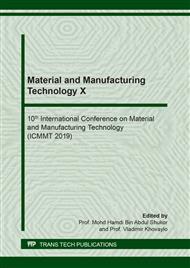[1]
C. N. Hoth , S. A. Choulis , P. Schilinsky , C. J. Brabec. High Photovoltaic Performance of Inkjet Printed Polymer:Fullerene Blends., Adv. Mater. 19 (2007) 3973-3978.
DOI: 10.1002/adma.200700911
Google Scholar
[2]
H. Sirringhaus , T. Kawase , R. H. Friend , T. Shimoda , M. Inbasekaran , W. Wu , E. P. Woo. High-Resolution Inkjet Printing of All-Polymer Transistor Circuits, Science 290 (2000) 2123-2126.
DOI: 10.1126/science.290.5499.2123
Google Scholar
[3]
Y. Kondo, H. Tanabe, T. Otake. Novel electrochromic polymer for electronic paper, IEICE Transactions on Electronics E93.C (2010) 1602-1606.
DOI: 10.1587/transele.e93.c.1602
Google Scholar
[4]
L. Hu, J. W. Choi, Y. Yang, S. Jeong, F. La Mantia, L.-F. Cui, Y. Cui, Highly Conductive Paper for Energy Storage Devices, Proc Nat. Acad. Sci., 106 (2009) 21490.
DOI: 10.1073/pnas.0908858106
Google Scholar
[5]
V. Subramanian, J. M. J. Fréchet , P. C. Chang, D. Huang, J. B. Lee, S. E. Molesa, A. R. Murphy, D. R. Redinger, S. K. Volkman. Progress towards development of all-printed RFID tags: Materials, Processes, and Devices", Proceedings of the IEEE 93 (2005) 1330-1338.
DOI: 10.1109/jproc.2005.850305
Google Scholar
[6]
C. T. Wang , K. Y. Huang , D. T. W. Lin , W. C. Liao , H. W. Lin , Y. C. Hu. Reactive silver inks for high performance printed electronics, Sensors 10 (2010) 5054-5062.
Google Scholar
[7]
J. S. Kang, J. Ryu, H.S. Kim, H.T. Hahn. Sintering of inkjet-printed silver nanoparticles at room temperature using intense pulsed light, J. of Elec. Mater. 40 (2011) 2268-2277.
DOI: 10.1007/s11664-011-1711-0
Google Scholar
[8]
S. Merilampi, T. Laine-Ma, P. Ruuskanen. The characterization of electrically conductive silver ink patterns on flexible substrates. Microelectron. Reliab. 49 (2009) 782–790.
DOI: 10.1016/j.microrel.2009.04.004
Google Scholar
[9]
S. Magdassi, M. Grouchko, O. Berezin, A. Kamyshny, Triggering the sintering of silver nanoparticles at room temperature, ACS Nano. 4 (2010) 1943-1948.
DOI: 10.1021/nn901868t
Google Scholar
[10]
M. Layani, M. Grouchko, S. Shemesh, S. Magdassi, Conductive patterns on plastic substrates by sequential inkjet printing of silver nanoparticles and electrolyte sintering solutions, J. Mater. Chem. 22 (2012) 14349-14352.
DOI: 10.1039/c2jm32789a
Google Scholar
[11]
E. Datu, M. D. Balela, In situ electrochemical study of copper nanoparticles stabilized with food grade gelatin, Key Engineering Materials 705 (2016) 163-167.
DOI: 10.4028/www.scientific.net/kem.705.163
Google Scholar
[12]
M. Tan and M. D. L. Balela, Electrochemical Investigation of the Growth of Copper Nanowires in the Presence of Ethylenediamine through Mixed Potential, J. Electrochem. Soc., 164 (2017) 7.
DOI: 10.1149/2.0491707jes
Google Scholar
[13]
D. Corsino, M.D. Balela. Room temperature sintering of printer silver nanoparticle conductive ink, IOP Conf. Ser.: Mater. Sci. Eng. 264 (2017) 012020.
DOI: 10.1088/1757-899x/264/1/012020
Google Scholar
[14]
N. De Guzman, M. Ramos, Jr., M. D. Balela. Improvements in the electroless deposition of Ag nanowires in hot ethylene glycol for resistive touchscreen device, Materials Research Bulletin 106 (2018) 446-454.
DOI: 10.1016/j.materresbull.2018.06.030
Google Scholar
[15]
N. De Guzman, M.D. Balela. Growth of ultralong Ag nanowires by electroless deposition in hot ethylene glycol for flexible transparent conducting electrodes, Journal of Nanomaterials 2017 (2017) 14 pages.
DOI: 10.1155/2017/7896094
Google Scholar
[16]
T. H. J van Osch, J. Perelaer, A.W.M. de Laat, U.S. Schubert. Inkjet printing of narrow conductive tracks on untreated polymeric substrates, Adv. Mater. 20 (2008) 343–345.
DOI: 10.1002/adma.200701876
Google Scholar
[17]
S. Sivaramakrishnan, P.J. Chia, Y.C. Yeo, L.L. Chua, P.K.H. Ho. Controlled insulator-to-metal transformation in printable polymer composites with nanometal clusters, Nat. Mater. 6 (2007) 149–155.
DOI: 10.1038/nmat1806
Google Scholar
[18]
J. Perelaer, B.J de Gans, U.S. Schubert. Ink-jet printing and microwave sintering of conductive silver tracks. Adv. Mater. 18 (2006) 2101–2104.
DOI: 10.1002/adma.200502422
Google Scholar
[19]
S. Joo, D.F. Baldwin. Performance of silver nano particles as an electronics packaging interconnects material. Elec. Comp. C (2007) 212–226.
DOI: 10.1109/ectc.2007.373801
Google Scholar
[20]
A. C. Siegel, S. T. Phillips , M. D. Dickey , N. Lu , Z. Suo , G. M. Whitesides. Printable Electronics: Foldable Printed Circuit Boards on Paper Substrates, Adv. Funct. Mater. 20 (2010) 28.
DOI: 10.1002/adfm.200990114
Google Scholar
[21]
A. Rida , L. Yang , R. Vyas , M. M. Tentzeris. Conductive inkjet-printed antennas on flexible low-cost paper-based substrates for RFID and WSN applications, IEEE Antennas Propagation Mag. 51 (2009) 13-23.
DOI: 10.1109/map.2009.5251188
Google Scholar
[22]
M. Layani, S. Magdassi. Flexible transparent conductive coatings by combining self-assembly with sintering of silver nanoparticles performed at room temperature, J. Mater. Chem. 21 (2011) 15378–15382.
DOI: 10.1039/c1jm13174e
Google Scholar
[23]
M. Grouchko, A. Kamyshny, C.F. Mihailescu, D.F. Anghel, S. Magdassi. Conductive inks with a built-in, mechanism that enables sintering room temperature, ACS Nano 5 (2011) 3354-3359.
DOI: 10.1021/nn2005848
Google Scholar
[24]
B. F. Rezaga, M. D. Balela. Sintering of silver nanoparticles at room-temperature for conductive ink applications, Key Engineering Materials 775 (2018) 144-148.
DOI: 10.4028/www.scientific.net/kem.775.144
Google Scholar
[25]
Y. Long, J. Wu, H. Wang, X. Zhang, N. Zhao, J. Xu. Rapid sintering of silver nanoparticles in an electrolyte solution at room temperature and its application to fabricate conductive silver films using polydopamine as adhesive layers, J. Mater. Chem. 21 (2011) 4875-4881.
DOI: 10.1039/c0jm03838e
Google Scholar


